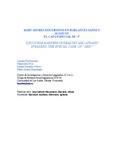| dc.rights.license | http://creativecommons.org/licenses/by-nc-sa/3.0/ve/ | |
| dc.contributor.author | Pietrosemoli, Lourdes | |
| dc.contributor.author | Vera, Marianelly | |
| dc.contributor.author | González Valera, Sandra Elena | |
| dc.contributor.author | Coutín Churchman, Pedro | |
| dc.date.accessioned | 2011-11-03T15:09:15Z | |
| dc.date.available | 2011-11-03T15:09:15Z | |
| dc.date.issued | 2011-11-03T15:09:15Z | |
| dc.identifier.uri | http://www.saber.ula.ve/handle/123456789/34025 | |
| dc.description.abstract | Este estudio presenta una comparación del uso de los marcadores discursivos (MDs)1
empleados por tres grupos de personas: 20 personas sanas, 25 pacientes con daño cerebral
izquierdo y 10 pacientes con daño cerebral derecho. El análisis de varianza (ANOVA)
muestra que aunque hay diferencia significativa (p= ,000) respecto al número total de
marcadores en el habla de los tres grupos examinados, no la hay en cuanto a la cantidad
relativa empleada por cada grupo. Se encuentra también un predominio de ‘y’ como
marcador en todos los grupos. En todos ellos, la frecuencia de ‘y’ es alrededor del doble del
marcador más próximo. Se propone que ‘y’ tiene características que le permiten convertirse
en el marcador por omisión. Por otra parte se plantea que los MD, a pesar de ser unidades
fonética y semánticamente de poco peso son tan importantes en la orientación del discurso,
que su uso se preserva en la afasia. | es_VE |
| dc.language.iso | es | es_VE |
| dc.rights | info:eu-repo/semantics/openAccess | |
| dc.subject | Marcadores discursivos | es_VE |
| dc.subject | Discurso | es_VE |
| dc.subject | Afasia | es_VE |
| dc.title | Discourse markers in healthy and aphasic speakers. The special case of “and” | es_VE |
| dc.title.alternative | Marcadores discursivos en hablantes sanos y afásicos: el caso especial de ‘y’ | es_VE |
| dc.type | info:eu-repo/semantics/article | |
| dc.description.abstract1 | This study compares the use of discourse markers (DMs) in three different populations: 20
speakers with no cerebral damage, 25 patients with left hemisphere damage and 10 patients
with right hemisphere damage. The analysis of variance (ANOVA) shows significance (p=
.000) concerning total use of discourse markers between groups, but no significance in the
relative use of DMs. The study also found a prevalence of ‘y’ whose frequency doubles that
of other discourse markers. We suggest ‘y’ has the features of a ‘default marker’ in all
populations. Finally, we propose that DMs, in spite of their reduced phonetic and semantic
weight, are so important in the orientation of discourse that its use is preserved in aphasia. | es_VE |
| dc.description.colacion | 1-21 | es_VE |
| dc.description.email | lourdes@ula.ve | es_VE |
| dc.subject.departamento | Departamento de Lingüística | es_VE |
| dc.subject.escuela | Escuela de Letras | es_VE |
| dc.subject.facultad | Facultad de Humanidades y Educación | es_VE |
| dc.subject.keywords | Discourse markers | es_VE |
| dc.subject.keywords | Discourse | es_VE |
| dc.subject.keywords | Aphasia | es_VE |
| dc.subject.thematiccategory | Artes y Humanidades | es_VE |
| dc.subject.tipo | Artículos | es_VE |
| dc.type.media | Texto | es_VE |


